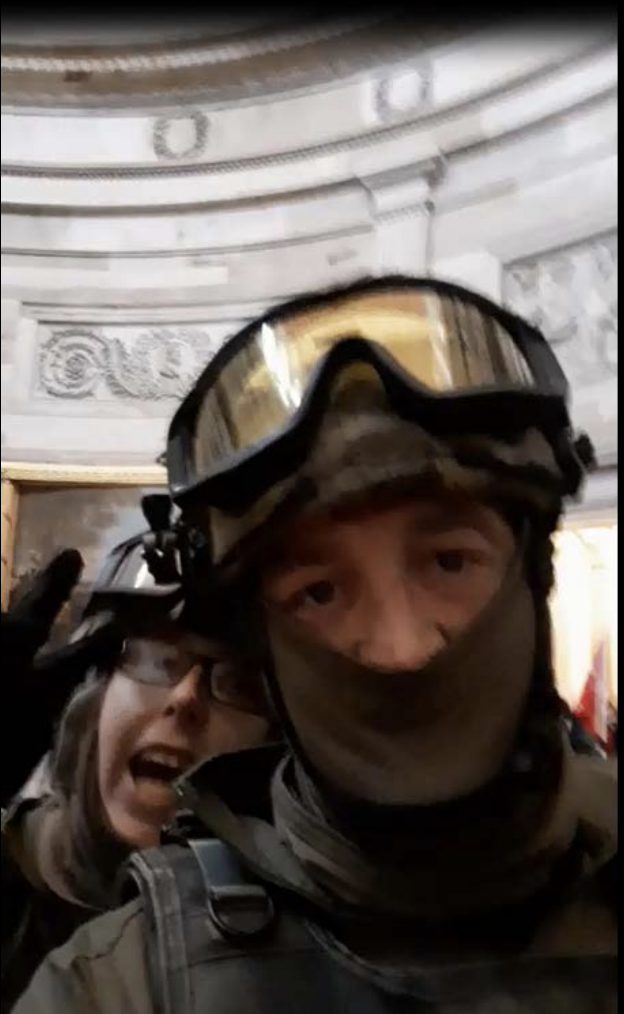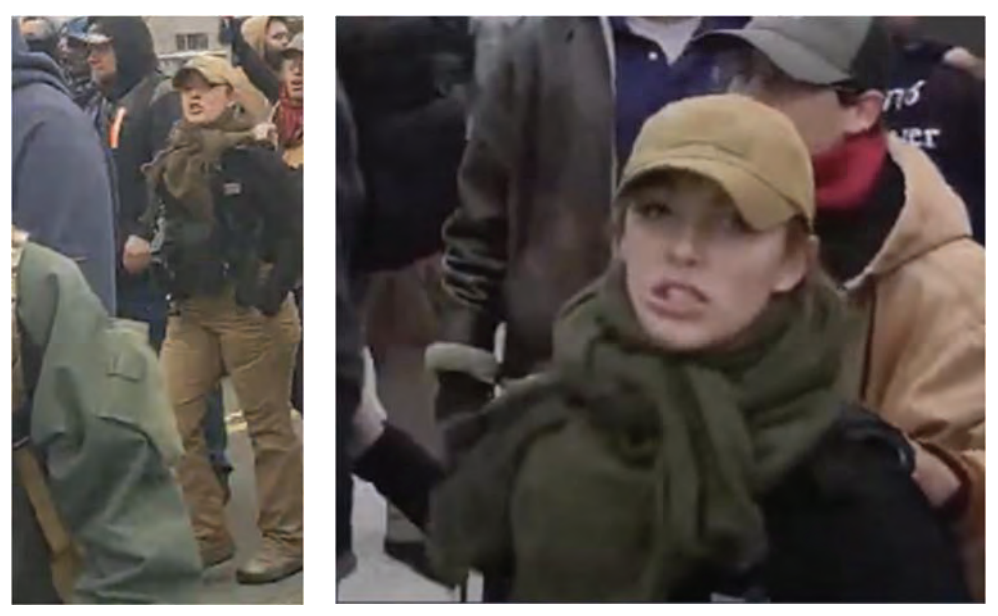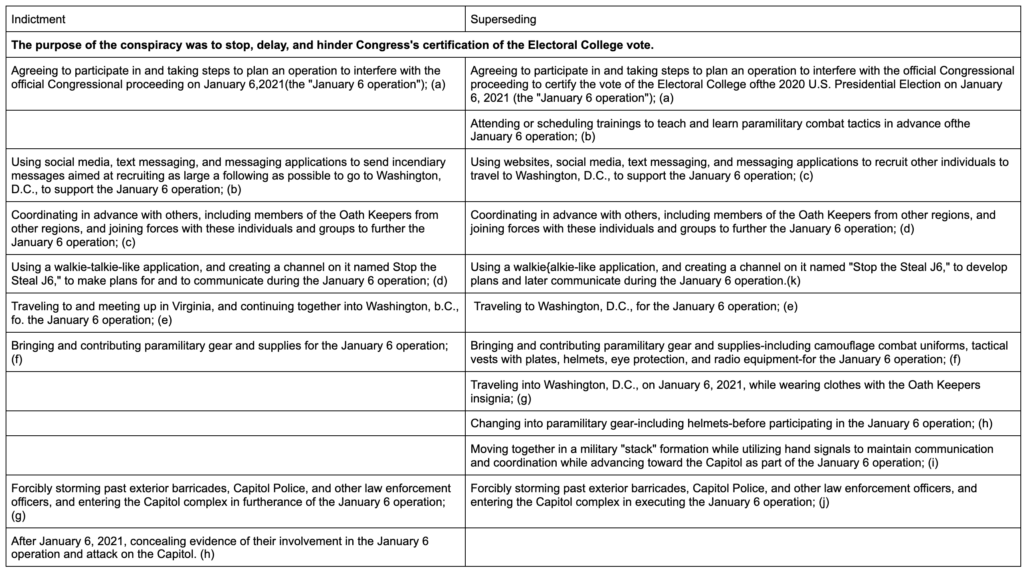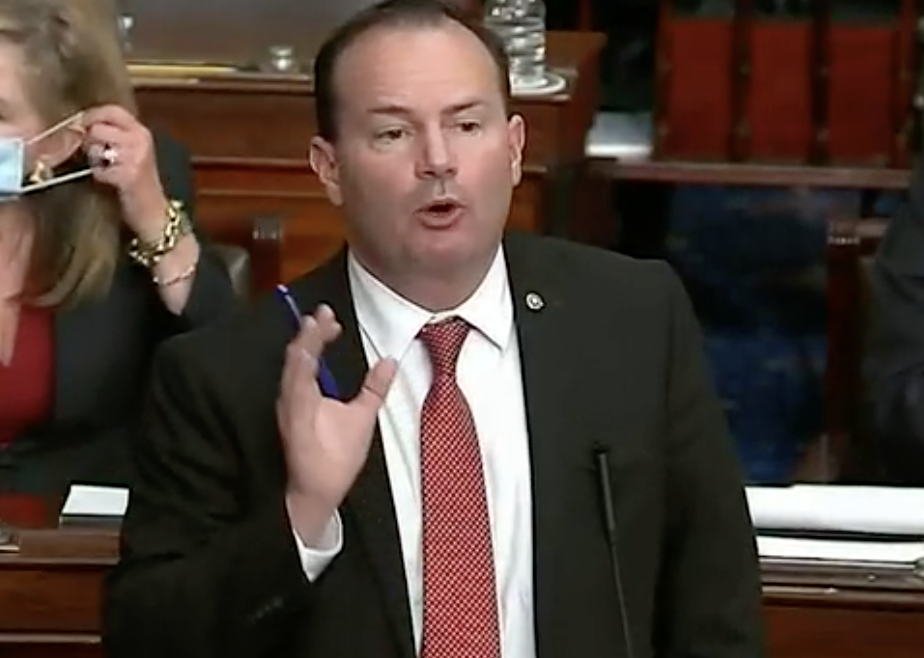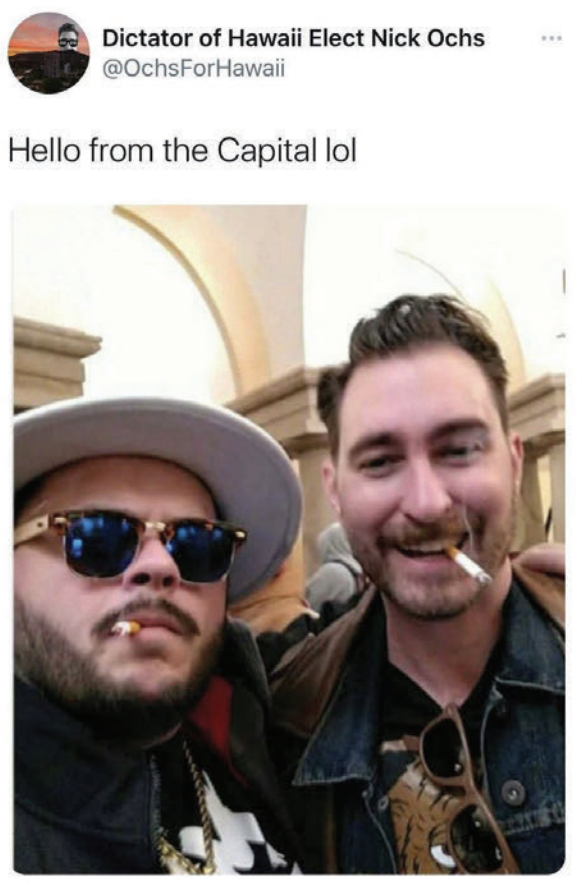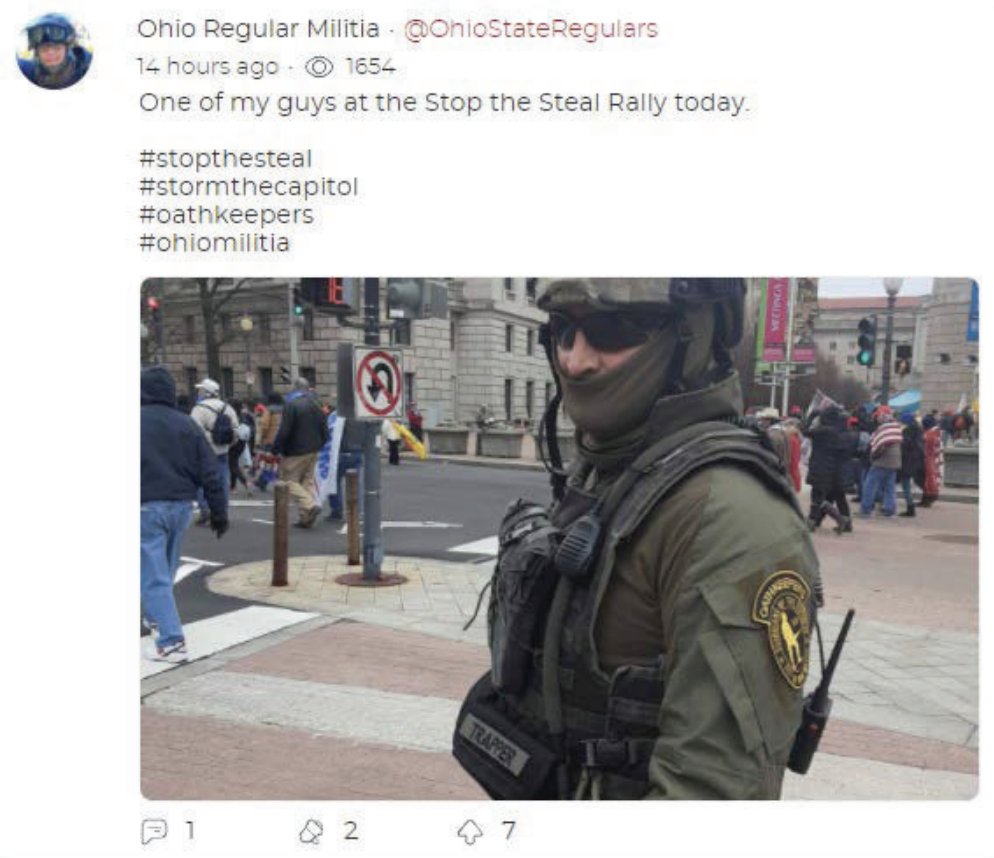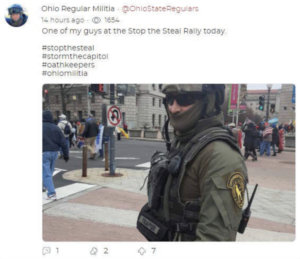Beryl Howell Takes an Early Swipe at the Trump Made-Me-Do-It Defense and Other Detention Standards
When DC Chief Judge Beryl Howell ordered Richard Barnett detained pending trial, the only record of her judgement — beyond her strong language at the detention hearing — was the order itself, including a paragraph about Barnett’s, “brazen conduct.” When she ordered Rachel Powell released to home detention, she released no opinion.
But when she ordered Proud Boy William Chrestman detained until trial, she wrote a 32-page opinion explaining her thinking. With regards to Chrestman — who threatened a cop, carried an axe-handle as weapon, and organized a cell of people who worked together to prevent police from expelling insurrectionists — Howell judged that his pre-trial detention wasn’t a close call: he poses a danger to the nation.
Defendant’s conduct on January 6 and blatant disregard for the law clearly show that he is a serious danger to the community and the nation, and that no condition or combination of conditions can be imposed that will ensure his compliance with the law pending trial in this matter.
But as one after another DC District judge struggles with the difficult pre-trial detention questions and just days after Judge Amit Mehta noted that some of these legal questions will pertain to a significant number of January 6 decisions, Howell used her decision on Chrestman to address three issues that have been and will continue to be litigated by insurrectionists:
- Standards for review of magistrate decisions from other districts
- The distinctions between different roles in the insurrection
- The claim that Trump ordered or sanctioned insurrection
Magistrate decisions from other districts
As she did with a number of other defendants, after a magistrate in Kansas granted Chrestman pre-trial release, Judge Howell granted an emergency request from prosecutors staying that order for another review. And in at least one case where DC judges reviewed a magistrate’s decision (Dominic Pezzola), the defendant has tried to limit the scope of the review.
In most cases, January 6 defendants will have their cases initially reviewed by a magistrate local to their homes, only to be prosecuted in the DC District.
Perhaps to establish both the primacy and the scope of these District Court orders, in her opinion Howell reviews the requirements for granting a hearing on detention (both Jessica Watkins’ and Thomas Caldwell’s attorneys had argued their charged crimes did not merit a review).
As generally pertinent to charged offenses arising out of the January 6, 2021 assault on the Capitol, a detention hearing must be held on the government’s motion when the charged offense involves:
1. “[A] crime of violence,” id. § 3142(f)(1)(A), which is defined broadly as an offense having as an element the attempted, threatened, or actual use of physical force against a person or property of another, or a felony offense that, by its nature, involves a substantial risk that physical force against the person or property of another may be used in the course of committing the offense, id. § 3156(a)(4)(A)–(B);
2. “[A]n offense listed in section 2332b(g)(5)(B) for which a maximum term of imprisonment of 10 years or more is prescribed,” id. § 3142(f)(1)(A), which “list” includes “a violation of . . . [18 U.S.C. §] 1361 (relating to government property or contracts),” id. § 2332b(g)(5)(B)(i);4
3. “[A]ny felony that is not otherwise a crime of violence that involves . . . the possession or use of a firearm or destructive device . . . or any other dangerous weapon[,]” id. § 3142(f)(1)(E);
4. “[A] serious risk that such person will flee,” id. § 3142(f)(2)(A); or
5. “[A] serious risk that such person will obstruct or attempt to obstruct justice, or threaten, injure, or intimidate, or attempt to threaten, injure, or intimidate, a prospective witness or juror,” id. § 3142(f)(2)(B).
A subset of the types of offenses requiring a detention hearing triggers a rebuttable presumption “that no condition or combination of conditions will reasonably assure the appearance of the person as required and the safety of the community if the judicial officer finds that there is probable cause to believe that the person committed” that subset of offenses. Id. § 3142(e)(3). As pertinent to charged offenses arising out of the January 6, 2021 assault on the Capitol, that subset of offenses includes “an offense listed in section 2332b(g)(5)(B) of title 18, United States Code, for which a maximum term of imprisonment of 10 years or more is prescribed.” Id. § 3142(e)(3)(C).
4 18 U.S.C. § 2332b(g)(5) provides a definition for “the term ‘Federal crime of terrorism,’” when the offense is “a violation of” an enumerated list of Federal offenses set out in § 2332b(g)(5)(i)–(iv) and the offense “is calculated to influence or affect the conduct of government by intimidation or coercion, or to retaliate against government conduct,” id. § 2332b(g)(5)(A). While individuals involved in the January 6, 2021 assault on the Capitol expressed publicly the intent to disrupt a government function in certifying the results of the 2020 Presidential Election and to coerce such disruption by breaching the Capitol, to date, to the knowledge of this Judge, no person charged in connection with the assault on the Capitol has been charged with a “Federal crime of terrorism,” under chapter 113B of title 18, United States Code, but only with separate, predicate enumerated offenses, such as violation of 18 U.S.C. § 1361 (relating to government property or contracts).
Howell then reaffirms that when conducting such reviews, District Court judges conduct a de novo review (Dominic Pezzola’s attorney, for example, asked the District judge for a more limited review).
[B]oth the BRA and the Federal Magistrates Act, 28 U.S.C. § 636, support the conclusion, reached by every circuit to have considered the question, that a district court reviews a magistrate judge’s release or detention order de novo.
[snip]
First, the BRA vests the authority to review and ultimately to “determine[]” a motion for review of a pretrial release or detention order in a “judge of a court having original jurisdiction over the offense.” 18 U.S.C. § 3145. Even when reviewing an order issued under § 3142, then, the district court exercises its original jurisdiction over the case as a whole, not appellate jurisdiction over the magistrate judge’s release or detention order.
Thus in the Chrestman case and in the hundred or so detention motions that will come, Howell lays out, the DC District judge will — if the government requests a review under the available offenses — decide the detention question.
Distinctions between different roles in the insurrection
Howell then turns to the difficult question of presiding over the detention reviews for hundreds of defendants involved in an unprecedented crime. Before assessing the question with respect to Chrestman, she addresses the question more generally:
The BRA, of course, requires a reviewing court to assess the specific conduct of each defendant, but the varying results in these cases raise the natural question, given the undeniably traumatic events of January 6, of the standard against which a particular defendant’s actions on that day should be evaluated. Before evaluating the nature and circumstances of defendant’s specific conduct, then, consideration of the differentiating factors that warrant pretrial detention of certain defendants facing criminal liability for their participation in the mob and pretrial release of others is helpful.
She lays out the kind of things judges might consider (all but one of which happen to work against Chrestman, but which provide useful guidelines for others). This analysis covers three pages, but the questions she asks (I’ve changed the order slightly) are:
- Was the defendant charged with misdemeanor or felony offenses?
- Did the defendant remain on the Capitol grounds or breach the building?
- Did the defendant engage in planning before arriving at the Capitol, for example by obtaining weapons or gear?
- Did the defendant carry or use a dangerous weapon?
- Did the defendant coordinate with other participants before, during, or after the riot?
- Did the defendant assume a formal or de facto leadership role?
- Did the defendant injure or attempt to injure others?
- Did the defendant damage or attempt to damage federal property?
- Did the defendant threaten federal officers or law enforcement?
- Did the defendant specifically promote the disruption of the electoral vote?
These questions aren’t surprising. Similar questions (excepting the first) seem to guide the government’s charging decisions. Still, as Howell says explicitly, they offer a “useful framework” to help contextualize each defendant’s actions.
Using these guidelines, she assesses that Chrestman’s actions pose a particularly grave threat to the country.
The nature and circumstances of defendant’s offenses evince a clear disregard for the law, concerted and deliberate efforts to undermine law enforcement, and an apparent willingness to take coordinated, pre-planned, and egregious actions to achieve his unlawful aims, all of which indicate that he poses a danger to the community. This first factor weighs heavily in favor of detention.
Without relying on the framework of terrorism (though she describes Chrestman as “terrorizing elected officials”), Howell places the danger in Chrestman’s pre-planning and coordination to undermine government.
Defenses claiming to be following Trump’s orders
As I noted, in his bid for pre-trial release, Chrestman suggested that he believed he was operating with Trump’s approval.
To prefigure how those offenses relate to the likelihood of Mr. Chrestman succeeding on pretrial release, we must start long before January 6.
It is an astounding thing to imagine storming the United States Capitol with sticks and flags and bear spray, arrayed against armed and highly trained law enforcement. Only someone who thought they had an official endorsement would even attempt such a thing. And a Proud Boy who had been paying attention would very much believe he did. They watched as their “pro-America, pro-capitalism and pro-Trump” rhetorical strategy “allowed the Proud Boys to gain entry into the Republican mainstream.”11 They watched as law enforcement attacked Black Lives Matter and anti-fascism protestors, but escorted Proud Boys and their allies to safety.12 They watched as their leader, Enrique Tarrio, was named Florida state director of Latinos for Trump.13 They watched the Trump campaign, “well aware of the organized participation of Proud Boys rallies merging into Trump events. They don’t care.”14 They watched when then-President Trump, given an opportunity to disavow the Proud Boys, instead told them to “stand back and stand by.”15 They understood that phrase as “a call to arms and preparedness. It suggests that these groups, who are eager to do violence in any case, have the implicit approval of the state.”16 Having seen enough, the Proud Boys (and many others who heard the same message)17 acted on January 6.
In the guise of addressing Chrestman’s claim that he has a viable defense, even in spite of the overwhelming evidence against him, Howell takes an early swipe at a defense many, if not most, defendants are offering: Trump invited or ordered the insurrectionists to take the illegal actions.
Howell admits she’s reviewing the particular form of the argument Chrestman presented before it has been sufficiently briefed (without also noting that one after another defendant is already trying some version of it).
This theory has not been fully briefed by the parties, and the question of former President Trump’s responsibility, legal, moral, or otherwise, for the events of January 6, 2021 is not before this Court.
Defendant presents this defense only for the limited purpose of counterbalancing the overwhelming weight of the evidence against him.
Nevertheless, Howell reviews the precedents Chrestman invokes to suggest that he might be excused for following Trump’s directions by distinguishing — first of all — between believing that a government official was describing the law accurately and, as happened here, believing that a government official could bless a “waiver of law.”
Nonetheless, in order to measure properly defendant’s potential privilege against liability against the government’s proffer, some exploration of the proposed due process defense is necessary.
Defendant invokes a novel iteration of a complete defense to criminal liability that arises when an individual criminally prosecuted for an offense reasonably relied on statements made by a government official charged with “interpreting, administering, or enforcing the law defining the offense” and those statements actively misled the individual to believe that his or her conduct was legal. United States v. Cox, 906 F.3d 1170, 1191 (10th Cir. 2018) (internal quotation marks and citations omitted) (outlining the elements of the defense). “The defense . . . is based on fundamental fairness concerns of the Due Process Clause,” United States v. Spires, 79 F.3d 464, 466 (5th Cir. 1996), and thus relies on an assessment of whether the challenged prosecution “offends some principle of justice so rooted in the traditions and conscience of our people as to be ranked as fundamental,” Patterson v. New York, 432 U.S. 197, 202 (1977) (internal quotation marks and citation omitted), because of the lack of notice and fairness to the charged defendant. The Supreme Court recognized this defense, sometimes called “entrapment by estoppel,” in three cases, Raley v. Ohio, 360 U.S. 423 (1959), Cox v. Louisiana, 379 U.S. 559 (1965), and United States v. Pennsylvania Industrial Chemical Corp. (“PICCO”), 411 U.S. 655 (1973). Examination of these decisions shows first, that entrapment by estoppel is a narrowly tailored defense, available in very limited circumstances, and second, that this defense does not excuse defendant’s conduct in the instant case.
[snip]
[T]his trilogy of cases gives rise to an entrapment by estoppel defense under the Due Process Clause. That defense, however, is far more restricted than the capacious interpretation suggested by defendant, that “[i]f a federal official directs or permits a citizen to perform an act, the federal government cannot punish that act under the Due Process Clause.” Def.’s Mem. at 7. The few courts of appeals decisions to have addressed the reach of this trilogy of cases beyond their facts have distilled the limitations inherent in the facts of Raley, Cox, and PICCO into a fairly restrictive definition of the entrapment by estoppel defense that sets a high bar for defendants seeking to invoke it. Thus, “[t]o win an entrapment-by-estoppel claim, a defendant criminally prosecuted for an offense must prove (1) that a government agent actively misled him about the state of the law defining the offense; (2) that the government agent was responsible for interpreting, administering, or enforcing the law defining the offense; (3) that the defendant actually relied on the agent’s misleading pronouncement in committing the offense; and (4) that the defendant’s reliance was reasonable in light of the identity of the agent, the point of law misrepresented, and the substance of the misrepresentation.” Cox, 906 F.3d at 1191 (internal quotation marks and citations omitted).
The Court need not dally over the particulars of the defense to observe that, as applied generally to charged offenses arising out of the January 6, 2021 assault on the Capitol, an entrapment by estoppel defense is likely to fail. Central to Raley, Cox, and PICCO is the fact that the government actors in question provided relatively narrow misstatements of the law that bore directly on a defendant’s specific conduct. Each case involved either a misunderstanding of the controlling law or an effort by a government actor to answer to complex or ambiguous legal questions defining the scope of prohibited conduct under a given statute. Though the impact of the misrepresentations in these cases was ultimately to “forgive a breach of the criminal laws,” Cox, 379 U.S. at 588 (Clark, J., concurring in part and dissenting in part), none of the statements made by these actors implicated the potential “waiver of law,” or indeed, any intention to encourage the defendants to circumvent the law, that the Cox majority suggested would fall beyond the reach of the entrapment by estoppel defense, id. at 569. Moreover, in all three cases, the government actors’ statements were made in the specific exercise of the powers lawfully entrusted to them, of examining witnesses at Commission hearings, monitoring the location of demonstrations, and issuing technical regulations under a particular statute, respectively.
In contrast, January 6 defendants asserting the entrapment by estoppel defense could not argue that they were at all uncertain as to whether their conduct ran afoul of the criminal law, given the obvious police barricades, police lines, and police orders restricting entry at the Capitol. Rather, they would contend, as defendant does here, that “[t]he former President gave th[e] permission and privilege to the assembled mob on January 6” to violate the law. Def.’s Mem. at 11. The defense would not be premised, as it was in Raley, Cox, and PICCO, on a defendant’s confusion about the state of the law and a government official’s clarifying, if inaccurate, representations. It would instead rely on the premise that a defendant, though aware that his intended conduct was illegal, acted under the belief President Trump had waived the entire corpus of criminal law as it applied to the mob. [my emphasis]
Moreover, the instructions Trump purportedly gave cannot be deemed part of his job. Howell argues that under both the Take Care Clause and the Constitution, Trump cannot sanction illegal or unconstitutional acts.
No American President holds the power to sanction unlawful actions because this would make a farce of the rule of law. Just as the Supreme Court made clear in Cox that no Chief of Police could sanction “murder[] or robbery,” 379 U.S. at 569, notwithstanding this position of authority, no President may unilaterally abrogate criminal laws duly enacted by Congress as they apply to a subgroup of his most vehement supporters. Accepting that premise, even for the limited purpose of immunizing defendant and others similarly situated from criminal liability, would require this Court to accept that the President may prospectively shield whomever he pleases from prosecution simply by advising them that their conduct is lawful, in dereliction of his constitutional obligation to “take Care that the Laws be faithfully executed.”
[snip]
[A] President cannot, within the confines of his constitutional authority, prevent the constitutionally mandated certification of the results of a Presidential Election or encourage others to do so on his behalf, nor can he direct an assault on the coequal Legislative branch of government. Were a President to attempt to condone such conduct, he would act ultra vires and thus without the force of his constitutional authority.
This gets close to the argument I keep making, that a key step Trump took that day (and riled up the mob when it didn’t work) was to give another Constitutional officer, Mike Pence, an unconstitutional order. And I was surprised that Howell didn’t mention pardons, a means by which Trump, at least, has forgiven the illegal obstruction of justice done for his behalf. Similarly, I would expect more focus on the separation of powers.
Still, it’s a framework for responding to what already is a sea of defendants claiming they can’t be held accountable for their crimes because Donald Trump invited or ordered them to commit the crimes. And does so within a broader framework that may provide DC District judges some way to approach the detention challenges with some measure of consistency.


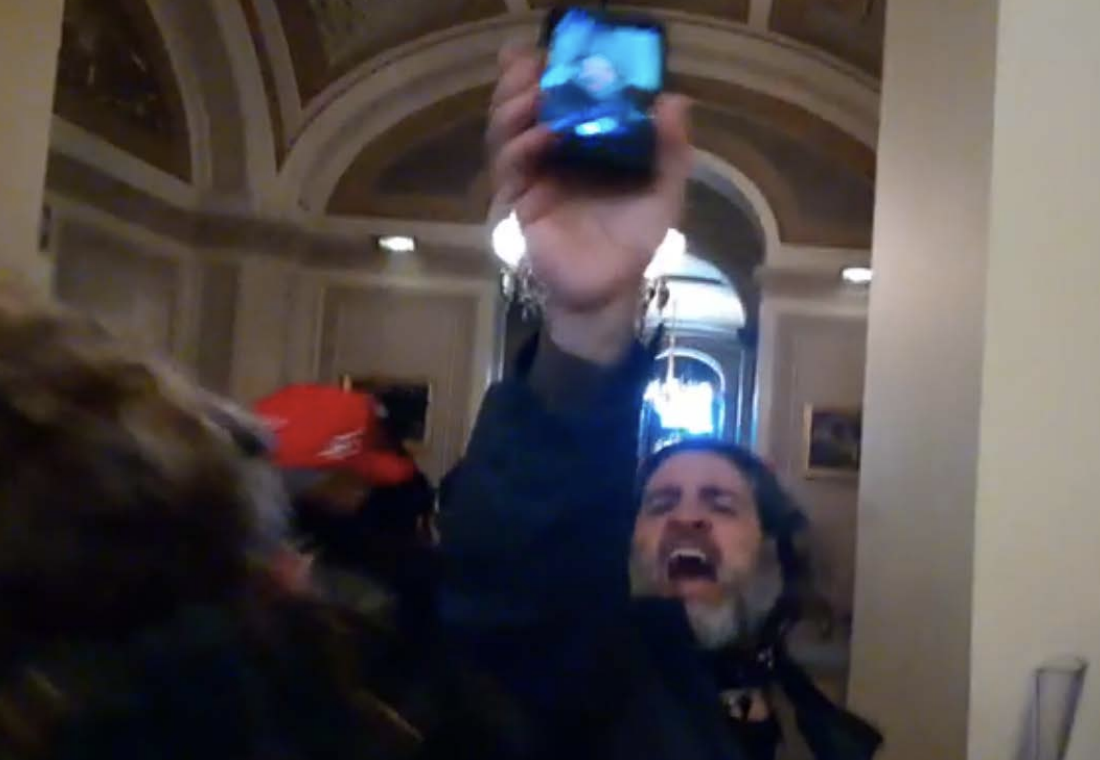 Pezzola
Pezzola